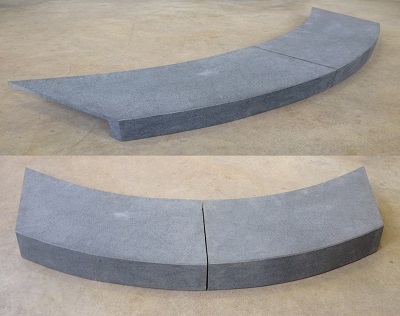All tips and guidelines below should be taken as general advice only and should be used in addition to the relevant Australian standards. These tips and advice in no way replace the service of your professional contractor or consultants.
GENERAL GUIDE TO CARE OF STONE PRODUCTS
Given stone is a natural product, variations in colour and texture may occur. It is the customer’s responsibility to inspect the material prior to commencing installation to check the colour, veining, thickness, sizing and finish of the product.
Absolutely no claims will be accepted for any reason after the material is installed.
You can view our full terms and conditions for further details at:
https://estonedirect.com.au/terms-conditions/.
Prior to Installation
All products must be inspected prior to installation. Any tile with excessive chipping, sizing and variation may be subject to a warranty claim. This needs to be done before installation.
Products are often packed wet at the point of production and may have some residue from the various finishing processes used. We recommend washing the tiles to remove residue and ensuring they are completely dry before installation.
Prior to installation, ensure batches of stone are shuffled and mixed to achieve evenness in distribution of any colour variation. This will mean opening all crates or pallets supplied prior to installation.
Stone tiles need to be graded prior to installation; the thicker tiles will dictate the non level and should be installed first. Thinner tiles should be bedded with an appropriate adhesive.
Minor damage such as edge chipping is often caused in packing or unpacking tiles, and should be expected. It is deemed normal practice for these to be used as cuts during the installation.
Dimensions listed are nominal as slight variation in size and thickness can occur with most natural material.
Installation & General Information
Foundation/ Substrates
The key to preventing problems occurring after tile installation is the correct preparation of the substrate prior to fixing. All substrates that are to be tiled on, floor or wall, should always be suitably prepared. They should be clean, flat, level, free from movement and free from anything which could be deleterious to adhesion.
An engineer can provide more accurate specification that are site
specific.
Common specifications are as follows:
- Pedestrian traffic only: reinforced concrete 75mm thick
- Vehicle traffic: reinforced concrete base at minimum of 100mm
Drainage and Slope
Waterproofing and subsurface drainage should be planned in advance in order
to prevent humidity from rising and contributing to efflorescence. It is important
to have an effective slope and perfect levelness on the floor to prevent water
from accumulating. Slope recommendations include:
- Small flooring surfaces: gradient >1% • Larger flooring surfaces: gradient >2%
Control joints
Control joints should be installed in accordance with the relevant building code. The joints in the concrete base should extend through the mortar bed and grout joint. The control joints enable the flooring to absorb temperature swings and other movements that may occur in the concrete base, subgrade, mortar, or tile itself. By using control joints, the risk of unsightly surface cracks will be greatly reduced.
Adhesion
The minimum and maximum bed thickness depends on the task at hand, but is also determined by the system of bonding such as adhesive fixing or mortar fixing.
All Stone tiles must be solidly bedded, with 100% adhesive coverage. We recommend Mapei, Kerakoll or Laticrete products for the installation process (There are many reputable companies) au.laticrete.com/ mapei.com/au
Fast setting adhesives are advisable to avoid issues with the moisture retention of some tiles. Light Coloured materials require fixing with white adhesives to prevent possible discoloration within the body of the stone. Flexible adhesives, combined with further substrate preparation, are required when the substrate is wood, or floor.
Grouts
When grouting it is recommended to use a high-quality grouting compound that is suitable for the application. Grouting products can be found at mapei.com/au. Please speak to your installer or a professional when selecting the correct grout for colour, suitability and durability.
Cutting
Cutting Stone is best cut with a bench saw with a diamond blade. The stone should be washed after cutting to remove all dirt and cutting paste. eStone Direct offers in-house fabrication to help reduce costs and save time. Please contact us for a cutting quote.
Please note that silica dust can be found in natural products and is recommend that safety and health-cautions are used whilst cutting
Cleaning
Ensure good commercial quality laying practices are adopted including cleaning off any residue or mortar stains as you go. Stone should be cleaned when grouting material has just set, this will ensure grout smear is removed. Use a cleaning agent suitable for the natural stone purchased. Never use hydrochloric acid unless directed.
Sealing
It is recommended to seal your natural stone products to obtain full performance. Products laid adjacent to a pool may require special attention.
Crystalline silica
Commonly known as silica dust which is found in sand, stone, concrete, mortar and a variety of products in the construction industry including bricks and plastics. Silica dust particles if exposed can cause health issues. To prevent and reduce this protective equipment must be worn whilst using tools to cut, grind, drill or any other procedures that involve manipulating the stone. Safety guidelines relating to silica must be obeyed. For more information, please see the link below. safeworkaustralia.gov.au/safety-topic/ hazards/crystalline-silica-and-silicosis
Please contact our team at eStone Direct for further hints and tips, and to clarify any further queries prior to laying the stone.
03 8838 1342
















